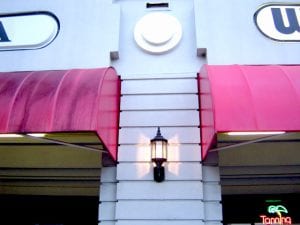What Ages Awnings?
If not maintained, the average awning starts looking dirty within several months and, depending on its material, can develop permanent staining within one or two years. By years four and five, most awnings will look filthy, may have sunburning along the upper surfaces, and the material will likely be weakened.
The flat top surface of awnings and the stress points, such as the curve from the vertical face to the horizontal top, will age the fastest. The vertical face of an awning is usually less sun-damaged, but may suffer from roof runoff, i.e., water that pours off the roof of the building and onto the awning creating black lines. The most destructive elements to awnings are sun exposure, air pollution, mildew, bird droppings, and roof runoff.
Another surprising factor in awning longevity is color. Red awnings age faster from sun damage due to the weakness of the pigment. Dark blue and dark green awnings are generally longer lasting.
It is especially important that red, white and yellow awnings get cleaned regularly and sealed with sealers with UV protectants. This will help protect against sun damage and staining to which these colors are more susceptible.
Awning cleaning and sealing can significantly extend the life span of all awnings, adding years to their useful life. Hiring a professional awning cleaner to keep the awnings cleaned and sealed and looking their best will end up saving the business owner thousands of dollars.
